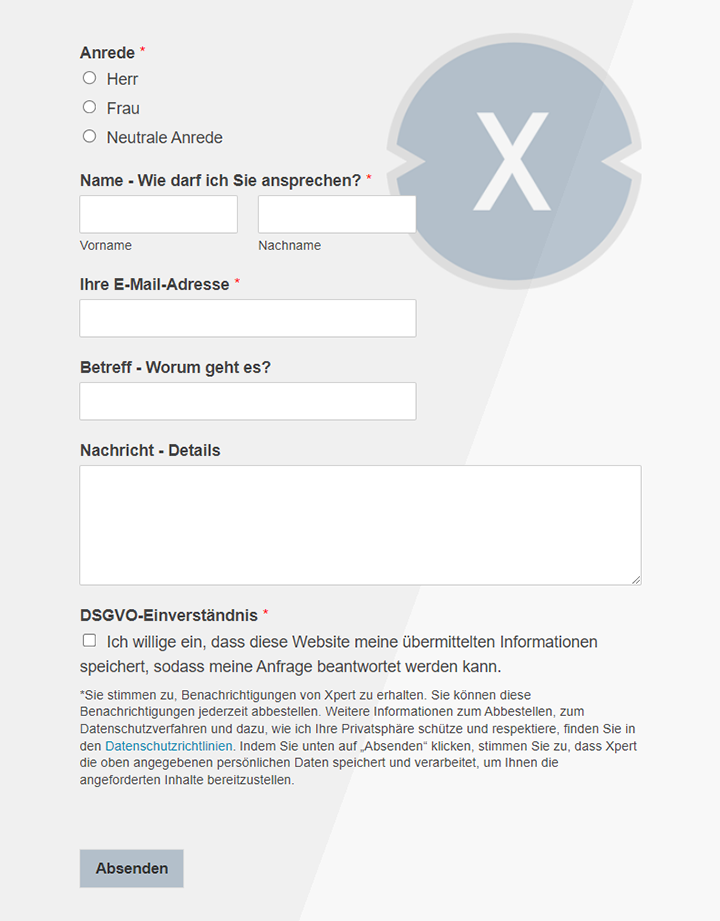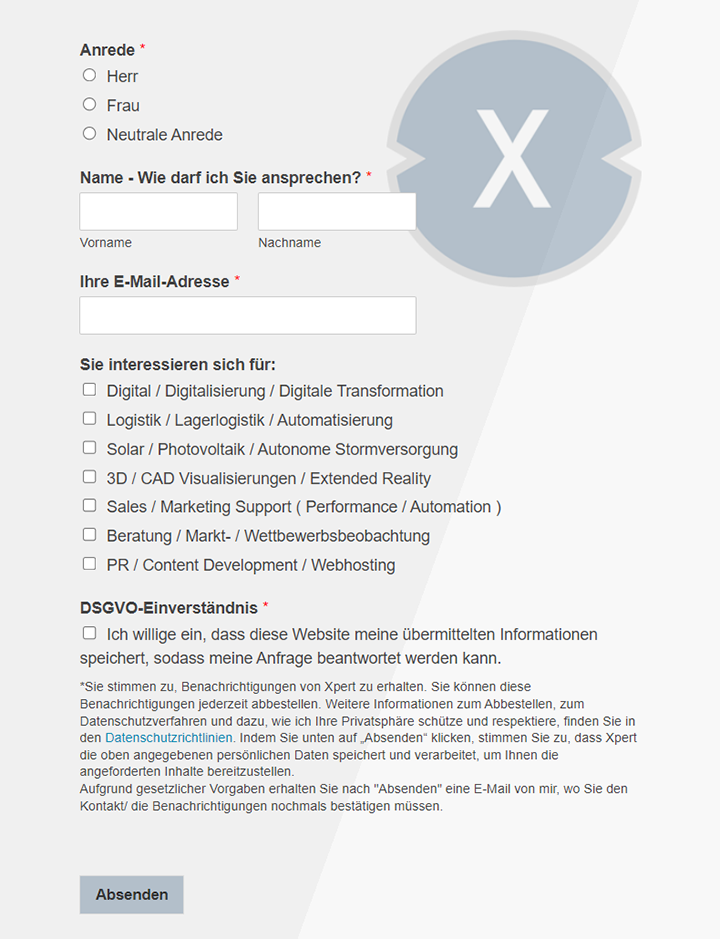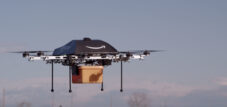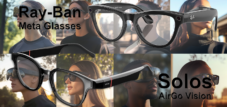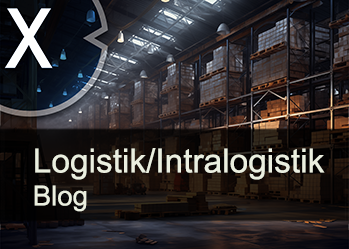Amazon's smart delivery glasses: Augmented reality for the technological rationalization of the last mile
Xpert pre-release
Language selection 📢
Published on: October 26, 2025 / Updated on: October 26, 2025 – Author: Konrad Wolfenstein

Amazon's smart delivery glasses: Augmented reality streamlines the last mile – Creative image: Xpert.Digital
When milliseconds become millions: The merciless battle for delivery efficiency
High-tech on the last mile: The economic calculation behind Amazon's delivery glasses
The idea of a future in which parcel delivery workers navigate using augmented reality glasses may initially seem futuristic. But Amazon's development of smart delivery glasses for its delivery partners reveals a fundamental economic truth of modern logistics: In a business model based on economies of scale, even minimal efficiency gains become decisive competitive advantages when replicated millions of times. The smart delivery glasses, which Amazon has been testing since October 2024, are more than just a technological gadget. They represent a strategic attempt to optimize the most costly and complex phase of the entire supply chain: the last mile to the customer's doorstep.
The economic logic behind this innovation becomes clear when considering the structure of delivery costs. The last mile accounts for between 41 and 53 percent of total delivery costs, even though it often represents only a fraction of the distance traveled. In the third quarter of 2023, Amazon's shipping costs amounted to $23.5 billion, an eight percent increase over the previous year. With a daily parcel volume of over 13 million shipments, every second saved per delivery represents a substantial cost advantage. If the smart glasses manage to reduce the delivery time per parcel by even just ten seconds on average, this adds up to significant savings in labor, fuel, and vehicle wear and tear across millions of daily deliveries.
The technical functionality of the glasses demonstrates how Amazon is trying to eliminate inefficiencies in the delivery microprocess. As soon as the driver reaches a safe parking spot, the system activates automatically and displays relevant delivery information directly in the field of vision. The glasses can scan packages and verify whether it is the correct package for the intended address. This eliminates the time-consuming process of drivers switching back and forth between their smartphone, the package, and their surroundings. After exiting the vehicle, the delivery driver receives turn-by-turn pedestrian navigation to the exact drop-off location, supported by Amazon's geospatial technology. In complex apartment buildings, the system is designed to guide the driver safely to their destination and warn of potential hazards.
The hardware architecture reflects the practical requirements of everyday delivery work. The glasses are connected via a cable to a controller housed in the driver's delivery vest. This contains the controls and a replaceable battery designed to ensure all-day use. A dedicated emergency button enables direct contact with emergency services. The lenses are self-tinting, thus also functioning as sunglasses. Prescription lenses can also be inserted, increasing acceptance among eyeglass wearers. These thoughtful details demonstrate that Amazon did not develop the technology as an isolated product, but rather designed it as an integral part of the workflow.
Suitable for:
- Amazon and Walmart's logistics battlefield: faster, greener, cheaper-the last mile changes e-commerce
The algorithm as boss: How data glasses are redefining work control
Behind this seemingly harmless navigation aid lies a far-reaching transformation of work organization. The smart glasses are part of a broader technological ecosystem that Amazon uses to optimize and monitor its delivery processes. The glasses continuously collect data on every aspect of the delivery process: timestamps for each stop, movement patterns, dwell times at various locations, scanning processes, and potential delays. This information flows in real time into Amazon's algorithms, which calculate key performance indicators and identify optimization opportunities.
This form of data-driven work organization raises fundamental questions about the distribution of power in modern employment relationships. Amazon operates its delivery network through the Delivery Service Partner Program, in which independent contractors operate their own delivery fleets. More than 3,000 such partners worldwide employ a total of approximately 150,000 drivers. Amazon has invested a total of $16.7 billion in this program since 2018, including $1.9 billion in 2024 alone. The entry cost for partners is approximately $10,000, with proof of $30,000 in available assets. This structure allows Amazon to massively scale its delivery capacity without the legal and financial obligations of a direct employer.
However, the introduction of smart glasses strengthens Amazon's de facto control over the work process. While the DSP partners are formally the employers, Amazon uses technology to dictate the parameters of work execution: optimal routes, delivery sequences, time windows, and key performance indicators. Drivers report that Amazon's algorithms continuously evaluate their performance and threaten consequences if they fall short of targets. A Reddit thread from Amazon DSP drivers confirms that the system automatically assigns more stops and packages when drivers complete their routes quickly. Amazon Logistics' artificial intelligence determines how many stops per hour a driver can manage based on speed in certain areas. For example, if a driver reaches a limit of 180 stops, the system gradually increases the package volume. If the driver cannot manage the workload, the system reduces stops and volume again.
This algorithmic control creates a gray area in the legal classification of employment relationships. While Amazon argues that DSP drivers are independent contractors, the company uses technology to exert a form of control that parallels traditional employer-employee relationships. This issue gained momentum in 2024, when thousands of Amazon delivery drivers went on strike and the Teamsters union demanded formal recognition and collective bargaining. The drivers argue that Amazon controls their daily operations, package quotas, and performance monitoring—functions typically performed by an employer. This gray area represents a central point of contention in the debate over workers' rights in the platform economy.
From data point to money: The tough ROI calculation behind AR glasses
The economic justification for investing in AR glasses lies in the mathematics of economies of scale. With an estimated investment volume spanning development, hardware, and implementation, Amazon must be able to demonstrate that the technology delivers substantial efficiency gains. Industry analyses show that companies that use wearable technology in logistics experience an average 8.5 percent increase in productivity, a 7.2 percent reduction in operational errors, and a 30 percent reduction in workplace accidents. Warehouse solutions with asset-tracking wearables have reduced inventory losses by up to 27 percent.
Implementing augmented reality in manufacturing provides concrete benchmarks for potential savings. An aerospace manufacturer reported 34 percent higher assembly speed and zero nonconformities for complex parts after implementing AR solutions. A commercial vehicle manufacturer halved cycle time for wire harness assembly and reduced rework by 80 percent using AR-assisted projection. Latecoere, a leading manufacturer of aerospace structures, reduced inspection times by up to 30 percent using AR-assisted methods. Safran, a global aerospace supplier, achieved four times the efficiency of inbound inspections and reduced non-quality costs in paint masking operations by a factor of seven using AR technology.
Applied to delivery logistics, even conservative estimates translate into significant savings. If the glasses reduce the average delivery time per package by just five to ten seconds, this translates to thousands of saved labor hours per day, based on millions of daily deliveries. With an average hourly wage of approximately $19.43 for delivery drivers, as reported by the Bureau of Labor Statistics, although actual costs vary widely by region, this results in significant labor savings. Added to this are reduced fuel costs through optimized routes and less vehicle wear and tear through more efficient trips.
The return on investment becomes even more favorable when indirect savings are considered. Automated warehouse systems typically achieve payback within six to 18 months. Training time for new employees drops from two to four weeks with traditional systems to one to two days with automated solutions. This not only reduces training costs but also enables faster scaling during peak periods. The improved ergonomics provided by hands-free working could also lower injury rates, reducing insurance costs and downtime. Warehouse workers sustain injuries at a rate of 5.5 per 100 employees, more than double the industry average of 2.7. Musculoskeletal disorders are the leading cause of injuries, often caused by repetitive, forced, and awkward movements without adequate recovery time.
Progress with side effects: Work pressure and health risks in the gig economy
The introduction of smart glasses is taking place in a broader context of fundamental changes in the organization of work. The gig economy, which includes Amazon's DSP model, has blurred the traditional boundaries between employees and the self-employed. Forecasts predict that gig workers will make up nearly 50 percent of the US workforce by 2025. This development is being driven by technological advances, changing employee expectations, and economic uncertainty. For companies, the model offers cost advantages of up to 30 percent, as many expenses and liabilities are shifted onto workers classified as contractors.
The downside of this flexibility is seen in harsh working conditions and income insecurity. Many Amazon delivery drivers report working days that regularly exceed ten to eleven hours, especially during peak season. While Amazon emphasizes that overtime is paid and the workweek cannot exceed 60 hours, peak workloads lead to considerable stress. A U.S. Senate report led by Bernie Sanders documented that Amazon pushes its warehouse workers to work at a pace that leads to increased injury rates, despite the company being aware of these dangers. The 18-month investigation confirmed allegations that workers and labor rights groups have been making for years. The report criticized Amazon for rejecting changes that could have slowed the pace of work and increased safety, citing concerns about profitability.
Injury rates in Amazon warehouses are alarming. Between 2016 and 2021, reported injuries and illnesses in warehouses nearly doubled, from 42,500 to 80,500 cases, an 89 percent increase that far exceeds the 14 percent growth rate of warehouses during that period. In New York State, the injury rate among warehouse workers increased by 30 percent from 2022 to 2023, to a rate of 11.5 per 100 full-time equivalent employees. This represents more than one injury for every nine warehouse workers each year, compared to one for every eleven the previous year. Injuries are also becoming more severe: in 2023, over 90 percent of injuries required missed days or a job change, compared to only 60 percent of injuries that were this serious in 2017.
The introduction of smart glasses could, paradoxically, both solve and exacerbate these problems. On the one hand, the technology promises improved ergonomics through hands-free working and warnings of hazards in the field of vision. The glasses could warn drivers of obstacles, poor lighting conditions, or animals, thus reducing the risk of accidents. On the other hand, there is a risk that the time saved by increased efficiency could lead to even higher performance expectations. If the system detects that drivers are working faster with the glasses, the algorithms could automatically assign more stops and packages, further increasing work intensity.
From delivery service to lifestyle product: Amazon's dual strategy in the AR competition
Amazon's foray into AR glasses for delivery drivers isn't taking place in a vacuum, but is part of an intense competition for dominance in the wearables market. Meta currently dominates the consumer smart glasses market, with a 73 percent market share in the first half of 2025. Ray-Ban Meta Smart Glasses saw over 200 percent year-over-year growth in the second quarter of 2025. Since the launch of the second generation in October 2023, over two million units have been sold. The global smart glasses market grew 110 percent year-over-year in the first half of 2025, driven by strong demand for Ray-Ban Meta Smart Glasses and the entry of new players such as Xiaomi, TCL-RayNeo, and several smaller brands.
The wearables in logistics market demonstrates impressive growth potential. The global wearables in logistics market size reached $3.8 billion in 2024 and is expected to grow at a robust CAGR of 18.2 percent from 2025 to 2033, with the total market value projected to reach $18.7 billion by 2033. The broader global wearable technology market was valued at $78.4 billion in 2024 and is expected to grow from $86.78 billion in 2025 to $191.58 billion by 2032. These figures highlight the enormous commercial potential offered by both consumer and enterprise applications of wearable technology.
Amazon is pursuing a dual strategy: The Smart Delivery Glasses for professional applications are being developed in parallel with the development of consumer AR glasses under the internal codename Jayhawk, which are expected to launch in late 2026 or early 2027. These consumer glasses are intended to overlay digital information on top of the physical world and enable users to see and interact with both the physical environment and the virtual world. The glasses are expected to be equipped with speakers, a microphone, and a camera, as well as a full-color display in a single lens. This strategy positions Amazon as a competitor to Meta, Google, and Apple in the emerging AR glasses market.
The development of the delivery glasses is based on Amazon's Echo Frames, which allow users to listen to audio and use voice commands via Alexa, Amazon's virtual assistant. Internally known as Amelia, the delivery glasses will feature a small display mounted on a lens and potentially be able to take photos of delivered packages as proof of delivery for customers. This technology transfer from the consumer to the enterprise sector demonstrates Amazon's ability to leverage synergies between different business units and amortize development costs across multiple product lines.
🎯🎯🎯 Benefit from Xpert.Digital's extensive, five-fold expertise in a comprehensive service package | BD, R&D, XR, PR & Digital Visibility Optimization

Benefit from Xpert.Digital's extensive, fivefold expertise in a comprehensive service package | R&D, XR, PR & Digital Visibility Optimization - Image: Xpert.Digital
Xpert.Digital has in-depth knowledge of various industries. This allows us to develop tailor-made strategies that are tailored precisely to the requirements and challenges of your specific market segment. By continually analyzing market trends and following industry developments, we can act with foresight and offer innovative solutions. Through the combination of experience and knowledge, we generate added value and give our customers a decisive competitive advantage.
More about it here:
Seeing Systems – The Power of Data: Amazon, Delivery and Market Strategy
The seeing system: How AI and computer vision drive logistics
Smart glasses are just the visible tip of a complex technological iceberg. The real innovation lies in the computer vision algorithms and artificial intelligence that process the collected visual data and transform it into actionable information. Computer vision in logistics uses artificial intelligence and deep learning to automate manual processes along the entire supply chain, reducing costs and accelerating operations. The global computer vision market is expected to grow to over $175.72 billion worldwide by 2032, driven by extensive use by leading companies such as Amazon, DHL, and UPS.
Amazon already uses computer vision in various areas of its logistics infrastructure. Researchers at Amazon trained machine learning models to detect product defects by comparing images of products with their intended condition. Cameras scan each item passing through the warehouse, and the model analyzes the scans to identify defects. Computer vision is also used in Amazon's robotic systems, such as Sparrow, Robin, and Cardinal. Sparrow can identify, pick up, and handle individual products in the warehouse. Robin and Cardinal, on the other hand, are used to handle packages after packaging. These innovations enabled Amazon employees to process over 13 million packages per day.
The application of computer vision in the delivery glasses extends these capabilities to the last mile. The glasses use AI-powered sensor capabilities and computer vision, along with cameras, to create a heads-up display that includes everything from navigation details to hazards and delivery tasks. When drivers safely park at a delivery location, the glasses automatically activate, and the delivery partner receives their delivery information directly in their field of view, from locating the correct packages in the vehicle to the corresponding addresses. The display then offers walk-through turn-by-turn navigation to the delivery address, leveraging Amazon's geospatial technology to guide drivers to the exact delivery location without having to check their smartphone.
Future versions of the glasses are expected to offer real-time defect detection, allowing the glasses to notify drivers if they've accidentally left a package at a customer's door that doesn't match the house or apartment number on the package. The system will also be able to detect pets in the yard and automatically adapt to hazards such as low light. These planned enhancements demonstrate Amazon's long-term vision of a comprehensive AI-powered delivery infrastructure that continuously learns and improves from data.
Suitable for:
The glass driver, the glass front door: Data protection as collateral damage
The continuous data collection by smart glasses raises fundamental questions about data privacy, both for drivers and recipients. The glasses capture potentially sensitive information about living conditions, daily routines, security features, and other private details. The planned photo feature for delivery documentation could capture images of entryways, gardens, and possibly people. This data flows into Amazon's extensive databases, where it can be linked to other information and used for various purposes.
Wearable technology in general poses significant privacy concerns. Each wearable device continuously collects thousands of data points per user per day. Over time, the cumulative data volume becomes enormous, and much of it is collected and processed without users' explicit understanding or control. Previous research has highlighted risks resulting from inadequate data protection, opaque third-party data-sharing practices, and regulatory gaps that leave users vulnerable to data breaches. Informed consent, a cornerstone of ethical data collection, is often undermined by lengthy and complex privacy policies, which in one study averaged 6,113 words and would require approximately 26 minutes of reading time. Not surprisingly, up to 97 percent of users accept these agreements without fully understanding their terms.
Information asymmetry exacerbates these challenges. Companies that operate or develop wearable devices possess far greater insight into the data lifecycle and algorithmic logic. Users, on the other hand, navigate vague and lengthy privacy policies with little understanding of how their information is handled. In this context, personal information and personal health information increasingly hold economic value, not only to support health-related services and personalized wellness initiatives, but also to generate data-driven insights. These insights can, in some cases, inform insurance assessments or corporate wellness programs, raising further concerns about the scope and purpose of data use beyond individual awareness.
For Amazon delivery drivers, an additional dimension of surveillance is added. The glasses enable seamless documentation of the work process at a level of granularity that would be impossible with traditional methods. Amazon can track how long a driver spends at each stop, the routes they take, where they pause, how fast they move, and even where they look. This data can be aggregated into comprehensive performance profiles that serve as the basis for evaluations, compensation, and employment decisions. Drivers have little opportunity to evade this surveillance, as the use of the technology will be virtually mandatory once it is rolled out across the board.
The global parcel flood: How e-commerce growth is forcing technological leaps
Investing in smart delivery glasses must be understood in the context of e-commerce's explosive growth momentum. The global e-commerce market is expected to reach a value of $10.19 trillion in 2025, growing at a CAGR of 15.8 percent, and is projected to reach $21.22 trillion by 2030. Over a third of the global population shops online, highlighting the increasing adaptability and accessibility of online shopping. China holds the largest e-commerce market globally at $3.19 trillion. Amazon dominates the US e-commerce market with a 37.6 percent share and remains the most visited e-commerce website, with an average of 2.48 billion monthly visits.
Mobile commerce is experiencing particularly dynamic growth. The mobile commerce market is expected to reach a value of $1.54 trillion in 2025 and grow to $2.12 trillion by 2030. More than 50 percent of online shoppers use mobile devices to shop. These trends demonstrate that people are increasingly spending their online time on mobile devices. In response, e-commerce companies are offering more options for shoppers to make purchases directly from their smartphones. Approximately 34 percent of shoppers shop online at least once a week. This rate rises to 82 percent when considering shoppers who shop online monthly.
This explosive growth is putting enormous pressure on the delivery infrastructure. According to McKinsey, despite declining global mail volumes, parcel volumes will increase at an annual growth rate of six to nine percent between now and 2028. B2B e-commerce deliveries are also on the rise, according to the International Trade Administration, driven by industries such as advanced manufacturing, energy, healthcare, and professional business services. As expectations for parcel delivery grow, both B2C and B2B organizations will increasingly seek innovative strategies for the final leg of the fulfillment journey.
The convergence of these trends is creating a massive market for logistics innovations. The industry is urgently seeking solutions to keep pace with rising demand while simultaneously controlling costs and maintaining service quality. In this context, investments in technologies such as smart glasses are not optional but becoming a competitive necessity. Companies that succeed in making their delivery processes substantially more efficient will gain decisive advantages in a market where speed and reliability are increasingly becoming differentiators.
Between relief and surveillance: Two scenarios for the future of work
Amazon's introduction of smart glasses is just one step in a broader transformation of logistics work. The future of delivery will likely be characterized by an intensive merging of human labor with AI-powered systems. The question is not whether automation will come, but how the benefits and burdens of this transformation will be distributed. The optimistic vision envisions a future in which technology eliminates the most dangerous and monotonous aspects of work, while humans can focus on more complex, fulfilling tasks. Wearable technology could reduce injury rates by warning workers of hazards and promoting ergonomic working practices. The improved efficiency could enable higher wages and better working conditions.
The pessimistic vision, on the other hand, envisions a future of intensified surveillance and work-frazzlement, where every second is measured and optimized, with humans essentially degraded to appendages of algorithmic control systems. The efficiency gains from technology flow exclusively to shareholders, while workers face stagnant wages, precarious employment, and increasing labor intensity. The legal gray area of the gig economy classification deprives workers of traditional protections while simultaneously exerting de facto employer control through technology.
The likely reality will lie somewhere between these extremes, shaped by legal frameworks, unionization, and societal norms. Experience with Amazon's Smart Delivery Glasses in the coming years will provide important insights into how this balance plays out. Initial feedback from test drivers is mixed. Kaleb M., a delivery partner working for Maddox Logistics Corporation in Omaha, Nebraska, who tested the technology, explained: "I felt safer the entire time because the glasses put the information directly in my field of vision. Instead of having to look down at a phone, you can shift your eyes forward and see beyond the display. You're always focused on what's in front of you."
Such positive reports, however, must be weighed against broader concerns about working conditions at Amazon. The turnover rate in Amazon warehouses typically exceeds 100 percent per year, likely due to strenuous working conditions. Warehouse work in general carries higher risks than average occupations, especially since the pandemic boosted e-commerce demand and made manual order fulfillment even more difficult. Challenges in recruiting and retaining talent have existed in the warehouse industry for some time. In this context, automation could be seen as a response to labor shortages rather than a threat to jobs.
The grasp for the entire chain: Amazon's strategy for logistics dominance
From a strategic perspective, the smart delivery glasses represent Amazon's attempt to defend and expand its dominance in e-commerce through vertical integration and technological innovation. The development of its own delivery capabilities, complemented by its DSP program, reduces Amazon's dependence on third-party courier services such as UPS and FedEx. The integration of advanced technology into every step of the supply chain, from automated warehouses to AI-assisted route optimization and now AR glasses for the last mile, creates efficiency advantages that are difficult for competitors to replicate.
This technological dominance also has defensive dimensions. Walmart has intensified its e-commerce initiatives and lowered prices, increasing competitive pressure on Amazon. Walmart has also introduced new incentives for independent delivery drivers to fulfill online orders during the shopping season. In this context, Amazon must continuously innovate to maintain its market position. The ability to deliver packages faster, more reliably, and more cost-effectively than competitors is becoming a decisive competitive advantage.
The development of delivery glasses also positions Amazon for future business opportunities. The experience gained and technologies developed in the enterprise sector can be transferred to consumer products. The planned Jayhawk consumer AR glasses could become a new product segment, complementing Amazon's hardware portfolio, which already includes Echo devices, Kindle, Fire tablets, and Ring security systems. Successful consumer AR glasses would provide Amazon with a platform to integrate its shopping experience even more seamlessly into customers' everyday lives, similar to how Amazon's Alexa voice assistant enables shopping through voice commands.
In the long term, Amazon's investment in AR technology could lead to a broader ecosystem where Amazon services are integrated across multiple touchpoints. Imagine a future where consumers wear AR glasses that guide them through stores, display product information, compare prices, and provide instant access to Amazon reviews, while simultaneously Amazon delivery drivers use the same technologies to deliver packages more efficiently. This vision of a comprehensive, AI-powered infrastructure for commerce and logistics would give Amazon an unprecedented position in the global economy.
However, the realization of this vision depends on numerous factors, some of which are beyond Amazon's control. Regulatory interventions could limit Amazon's market power. Antitrust authorities in the US and Europe are already investigating Amazon's business practices. Changes in labor laws could challenge the DSP model and force Amazon to classify drivers as employees, which would fundamentally change its cost structure. Data protection laws could restrict the collection and use of data by the glasses. Unionization could strengthen workers' bargaining power and lead to higher wages and better working conditions. Technological developments among competitors could erode Amazon's lead.
In this uncertain future, smart delivery glasses represent both a bet on technological progress and an attempt to define the terms of future competition. Whether this bet pays off will only become clear in the coming years. What is already clear: The way goods move from warehouses to doorsteps is undergoing a fundamental transformation. Amazon is determined to lead this transformation, and smart delivery glasses are a visible symbol of this ambition. The economic, social, and legal implications of this development will shape the world of work and the economy for years to come.
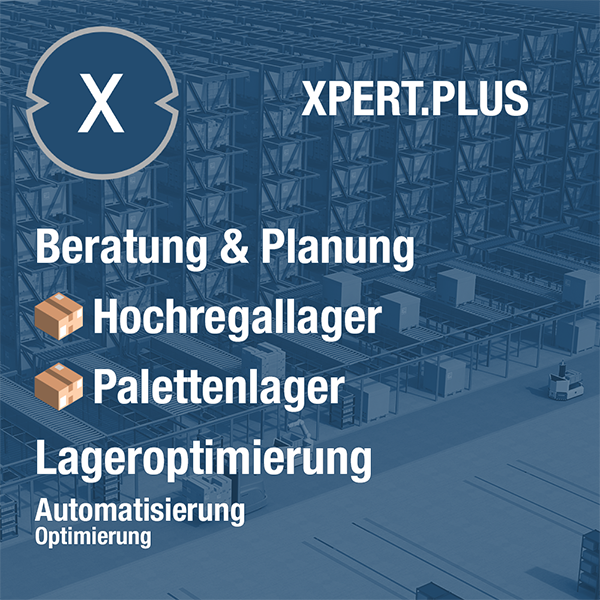
Xpert.Plus warehouse optimization - high-bay warehouses such as pallet warehouses consulting and planning
We are there for you - advice - planning - implementation - project management
☑️ SME support in strategy, consulting, planning and implementation
☑️ Creation or realignment of the digital strategy and digitalization
☑️ Expansion and optimization of international sales processes
☑️ Global & Digital B2B trading platforms
☑️ Pioneer Business Development
I would be happy to serve as your personal advisor.
You can contact me by filling out the contact form below or simply call me on +49 89 89 674 804 (Munich) .
I'm looking forward to our joint project.
Xpert.Digital - Konrad Wolfenstein
Xpert.Digital is a hub for industry with a focus on digitalization, mechanical engineering, logistics/intralogistics and photovoltaics.
With our 360° business development solution, we support well-known companies from new business to after sales.
Market intelligence, smarketing, marketing automation, content development, PR, mail campaigns, personalized social media and lead nurturing are part of our digital tools.
You can find out more at: www.xpert.digital - www.xpert.solar - www.xpert.plus






